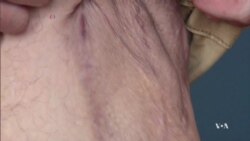The promise that stem cells may someday help regenerate damaged tissue seems to be close to fulfillment. Scientists at the University of Pittsburgh School of Medicine report that some of their severely injured patients grew new muscle tissue with the help of pigs’ bladders.
After a skiing accident in which he lost much of the muscle in his left calf, Nicholas Clark could no longer do many of his regular activities.
“In addition to the muscle loss, I had a lot of nerve loss and blood vessel loss and other tissue loss in that leg. So, it really limited any activity," said Clark.
Skeletal muscles can regenerate after minor injuries with help from physical therapy, but if the loss is greater than 20 percent, the damage becomes permanent, says Doctor Stephen Badylak of the University of Pittsburgh School of Medicine.
“You're left with this huge gap that just fills in with scar tissue," said Badylak.
Scientists have long known that stem cells, applied at the point of injury, can actually turn into new muscle cells. But they need some sort of structure - a matrix - to grow on.
Badylak's team created an “extracellular matrix” from a pig’s bladder. They removed all traces of cells from the tissue, so that the recipient’s immune system would not reject it.
“The extracellular matrix is the glue, if you will, that holds all of the cells in our body together," said Badylak.
The matrix is implanted at the injury site, and as it slowly degrades in recipient’s body it releases chemicals that attract stem cells. Physical therapy helps the stem cells understand that they need to form muscle tissue.
All five patients in Badylak's study had lost 60 to 90 percent of the affected muscle. Six months after the start of therapy, all have grown some new muscle, and three patients had dramatic improvement. Clark says he can ride his bike again and even jump rope.
“There are other things, just day to day things, that really make a huge difference," he said.
Scientists say they experimented mostly with old injuries, but that the new method probably works better for patients with more recent injuries.





